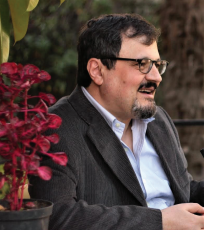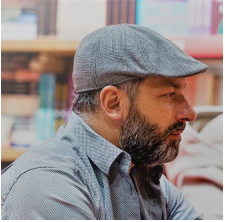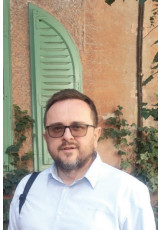A writer, publicist and linguist now based in New York, Ardian Vehbiu is the author of 15 books, including several works of fiction, as well as works of non-fiction focusing on the linguistic and semiotic aspects of contemporary Albanian culture. He has notably analyzed public discourse in totalitarian Albania and the nature of exchanges between cultures lacking common codes of communication. He is the founder, director and editor of “Peizazhe të fjalës” (Landscapes of the Word), an Albanian-language online cultural magazine.
It has been pointed out that Covid-19 is spread through speech: illustrations featuring swarms of viral particles bursting out of a disembodied mouth have left no room for imagination. And, as we have been taught by phoneticians, airstream coming from the lungs needs to overcome various “obstacles” in order to become speech: from the opening and closing vocal cords, to the expanding and contracting throat, the vibrating uvula and the undulating vellum, the tongue grazing and hitting the palate, gums and teeth, the constantly interacting lips and the occasional forays of airstream through the nose. These various obstacles can block air completely or stop it partially, thereby generating micro-bursts and sprays of saliva droplets that fly out of the speaker’s mouth to eventually reach the Other, the “receiver”, the person who you are speaking to. Which means, after all, that you as the speaker can – at least in theory – transmit not only the content of your speech into the other person’s mind, but also the viral and bacterial load of your phonetic apparatus (mouth, nose, throat, lungs) into the other person’s body.
And here things become even more fascinating, because languages also vary in the way they are phonetically articulated – suffice it to compare Italian to Dutch, and both of them to Chinese and Hawaiian (the latter having a quite reduced number of phonemes); which makes it therefore reasonable to ask whether some languages are more effective than others in passing on contagion of respiratory disease during an epidemic.
An essay by Julie Rose, “SARS and the City, Hong Kong Report,” published in Log, no. 1 (Fall 2003), pp. 123-140 mentions a hypothesis by Dr. Sakae Inoyue, according to which languages such as Chinese and English that make large use of aspiration – defined as the accompaniment of some obstruent sounds (p, t, k; f, s, v; ch – as in chair, j – as in jet) with a strong burst of breath – may have been instrumental in the diffusion of epidemic disease in the areas where they are used. An easy example of aspiration, in English, could be the difference between the p in pin, vis-à-vis the p in spin; or even compared to the p in the Italian piccolo. Dr. Inouye had announced her hypothesis via a letter published in The Lancet (“SARS transmission: language and droplet production,” see also here), where she argued that languages making frequent use of aspiration help expose “listeners” to a large number of virus-laden droplets, if spoken by infected people. Ironically, the English to speak is related to a proto-Indo-European root *spreg-, possibly meaning “spread, scatter”, which implicitly compares the act of speaking to a “spreading” of words.
Aspiration being quite active in some languages and absent in others, its role in spreading viruses or other types of germs affecting the human respiratory tract can arguably be measured in a lab. Furthermore, micro-bursts of breath droplets aren’t just limited to aspired consonants; certain languages stand out for the very “harsh” articulation of their fricatives (a type of consonant produced by forcing air through a narrow opening, to generate a turbulent air flow) that start in the back of the mouth, the uvula, and the pharynx and larynx. Take, for example, Arabic, which is especially rich in uvular, pharyngeal and pharyngealized consonants – produced in those exact respiratory tract spots where viruses and bacteria live and prosper; and which would make it likely for a sick speaker of Arabic to pass on their flu or Covid-19 to their live audience.
When we speak, we rely on the same organs, body parts and cavities that participate in the inhaling and exhaling of air during breathing, which means that, from an evolutionary linguistic point of view, it makes sense to ask whether infectious respiratory tract diseases have somehow influenced the constitution and change of the phonetic (and phonological) systems in various languages: one could study the correlation between aspiration/occlusion and the diffusion of saliva droplets or the relation between nasality and rhinitis or other nasal pathologies. A virus that succeeds in spreading via speaking acquires an advantage compared to another virus that fails to achieve this; relatedly, a virus that manages to spread via aspired or fricative guttural consonants might gain a further advantage, if it can also provide some other evolutionary benefit to speakers of aspiration-rich languages (compare this to the effects on mice and men of toxoplasma gondii, a parasite that causes toxoplasmosis and which can jump from cats to humans; read more here).
It would therefore be easy to imagine how a close talker presents us not only with his thoughts and feelings, but also with a large number of micro-organisms originating in his or her mouth, nose, throat and lungs; an exchange not unlike what happens in, say, unprotected sex: the same word, intercourse, is used in English to mark both communication between people and the sexual act (a kiss could be all it takes to pass on Herpes Simplex 1 and 2). Would this be enough, to think of biological material transfer as a factor in the process of courtship and seduction? To make the situation more complex, viruses carry with them chunks of their host’s genetic material which is then absorbed by the receiving body, thanks to the relentless copying of the virus itself inside the host’s cells: what even a French kiss cannot achieve, the spoken word can. If a certain language that makes abundant use of aspired guttural consonants helps its speakers share more viruses, bacteria and eventually genetic material, then articulatory phonetics could be seen as a factor in the cohesion of its community; in other words, that contagious respiratory disease is directly involved in the creation and reproduction of linguistic communities.
Dr. Sakae Inouye’s hypothesis gained a mention in the Annals of Improbable Research, the same organization that awards the infamous Ig Nobel Prizes; but this mention need not be used against it. Nobody should be mocked, today, if they take measures to protect themselves against the Other’s aspired consonants, guttural fricatives, pharyngeals and laryngeals. Not to dwell on that a recent study by the National Institutes of Health in Bethesda and Perelman School of Medicine at the University of Pennsylvania (quoted from this article) showed that, when subjects were asked to pronounce the English word healthy, the most emitted droplets were generated by the sound th, an interdental fricative.
Because of the Covid-19 crisis, scientists are paying increasing attention to the relationship between (direct) human voice and contagion: researchers at MIT Lincoln Laboratory were able to detect vocal biomarkers or measurable indicators of disease in recordings of people infected with Covid-19 but not yet showing symptoms. The next logical step would be coding these results into an app that would be – theoretically – capable of diagnosing the infection by simply “listening” to someone’s voice over the phone. While we don’t usually need an app in order to tell whether someone has a cold or the flu by the sound of their speech, the results obtained by the MIT researchers allow for at least suspecting that our brains also have ways of learning a lot from another person’s voice; and thus planning our approach to them, for example in deciding whether we should get closer or not during a conversation. Suddenly this acquires some urgency, in the context of all the fuss about preventing Covid-19 infection via “social distancing.”
While most of us see Covid-19 as a disease to be avoided at all costs, it is not entirely clear whether our bodies will fully cooperate with the guidelines issued by health authorities and confirmed by common sense. Scenarios could be envisaged, in which members of communities, including those that share the language, have a vested interest in getting the infection. As we speak, we pass on ideas, information, and feelings, as well as a lot more. Epidemiologists have told us that contagion, including Covid-19 contagion, most commonly occurs in enclosed spaces, such as restaurants, bars, cars, gyms, and crowded concerts halls, which are exactly the spaces where communities are maintained and reproduced. It has been shown that people in close contact share not only their words and breath, but also their bacterial flora and viral load; and bacterial flora in the gut and elsewhere is increasingly seen as a factor in determining what we do, what we think, how we behave and who we are.
On the other hand, mortal infectious diseases have historically come from outside the community, just like dangerous or disruptive ideas: the early spreaders and the super-spreaders act through their speech; in the same way as influencers, persuaders, opinion-makers and gurus manage to disseminate their ideas and habits through their words. Researchers have noticed how easy it is for Covid-19 to spread in religious communities or even in areas where collective activities or events take place – such as political meetings, choir practice and other types of gatherings: it seems as if viruses and ideas spread and get shared the same way. There is a special science, memetics, that studies self-replicating units of culture based on evolutionary models of cultural information transfer – a successful “meme” (the term is not related to Internet memes) is made to circulate through a larger number of minds. Whatever people might think of the status of memetics among the social sciences, one can hardly deny that the spread of Covid-19 closely paralleled the multiplication of talk about Covid-19; with the topic infecting social media as the virus infected people around the world. It is equally hard, therefore, not to see strong similarities between super-spreaders and various social media influencers; and perhaps easy to see fake news and disinformation about Covid-19 as a proprietary viral strategy, to the extent that it helps the virus propagate (by convincing people that the risk is overblown or outright invented).
The very prominence of the concept and practice of social distancing calls to mind the theories of Edward T. Hall, an American anthropologist who developed the concept of proxemics – a branch of knowledge that deals with the amount of space that people feel necessary to set between themselves and others; in other words, with how close people decide to stand next to someone during social interaction. Hall measured the distances that make up these interpersonal zones and found that middle-class Americans maintain four such distance zones, depending on how people are feeling towards each other: intimate distance, involving direct contact; personal distance, ranging from 1 to 4 feet, where subjects of personal interest can be discussed; social distance, ranging from 4 to 12 feet, where more formal business and social discourse takes place; and public distance, ranging from 12 to 25 feet or more. Significantly, Hall also noticed that these distances are culture-dependent, which means that what Italians or Middle Easterners may consider appropriate social distance, will be perceived instead as personal distance by Icelanders.
As people speak while in each other’s physical presence, language is just one among many things being exchanged: from gestures and postures, to facial expressions, vocal pitch and loudness and, lastly, biological material, including bacteria and viruses. Someone who speaks in a loud voice might cause their interlocutor to move away, while a close talker might make you move closer, in order to understand what is being said. On the other hand, loud speech causes more saliva droplets to leave the speaker’s mouth; the reason choir practice and group singing have been marked as critical in the spread of Covid-19.
The trivial fact that respiratory tract infections easily spread through speech suggests a much deeper correlation between our bodies and our minds, given that language that we use to communicate, generate and reproduce our thoughts as well as our communities is an overlapping of the physical and the social. Phonetic research, which relies on lab practices and exact measurements, will certainly lead the way in understanding how the spread and the sharing of germs help us see ourselves as members of communities that are equally social and physical.
Coda: COVIDICTIONARY
COVIDIOTS – all of us; see also COVIDIOCRACY
CO-VENI CO-VIDI CO-VICI: Covid’s conquering path
C-OVID – the poet we’re all waiting for, to tell us about viral mutations (Metamorphoses); see also COVIDEOS
COV-ID – I. we’re all going to be given one (ask for the chip) II. The dark side of the virus; see also FREUD
COVIDEAS – what we get when we don’t respect social distancing online; see also COVIDEOLOGY
COVIDEOGAME – the one we are all in it together (multiplayer)







